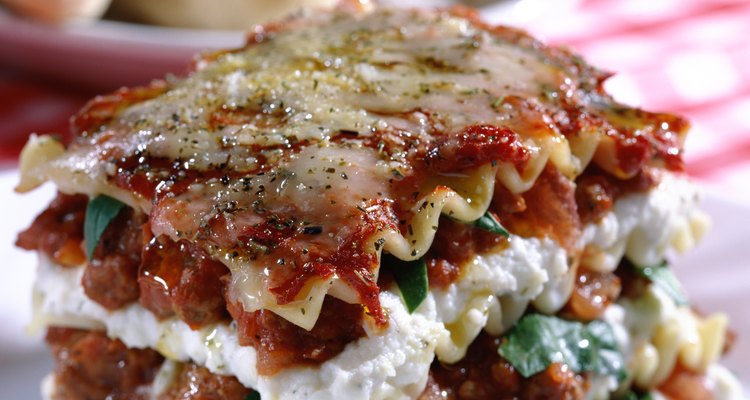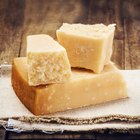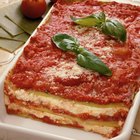
Jupiterimages/liquidlibrary/Getty Images
It's relatively easy to throw together a "quick-and-dirty" lasagna using no-cook noodles, sauce from a jar, and a bag of shredded cheese from your supermarket. Using a homemade sauce, prepared ahead and canned or frozen, can improve a lasagna's quality significantly. So can a layer of real ricotta cheese, carefully drained and seasoned.
About Ricotta
Italy has a rich cheesemaking tradition, and ricotta is one of its signature products. It's an example of the Mediterranean region's historic frugality, and unwillingness to let anything go to waste. It begins with the whey left over from making other cheeses, which -- as bodybuilders know -- still contains a high level of protein. It's traditionally made by heating and stirring the whey until its proteins begin to thicken and bond together, just as they do in an egg white as it cooks in your pan. The tiny curds are strained out of the whey, creating a very fine-grained cheese with a texture similar to thick sour cream or Greek yogurt.
Ricotta in Lasagna
Many Italian dishes use a rich, dairy-based component as a foil for the tangy acidity of tomato sauce. Sometimes it's by pairing the tomato sauce with a white sauce, but more often the dairy component comes from ricotta-based fillings. In lasagna, for example, a ricotta layer adds richness, mellows the tomato sauce, and -- another frugal consideration -- reduces the need for meat protein. Some brands of ricotta contain a small amount of whey or milk to keep it moist, and this should be drained before the ricotta is used. Some recipes add an egg or egg yolk to the cheese, which helps bind any excess liquid.
Basic Seasoning
Plain ricotta has a bland, neutral flavor, much like that of fresh milk. It's pleasant in its own right, but its neutrality can mute the lasagna's other flavors. To prevent that, it's usually seasoned lightly. A modest amount of salt is usually incorporated, to avoid the "flat" impression created by its absence. Most recipes also call for a hint of pepper or nutmeg, to brighten the flavor. A third form of seasoning is the other cheeses that are commonly added to the ricotta. These vary between cooks, but usually include a sharp and flavorful cheese such as Parmesan or Asiago.
Alternatives
That simple approach to seasoning is the most traditional, but many cooks like to dress up the plain ricotta layer with other flavors. The most common choice is fresh herbs, selected to complement the flavors in the sauce. These might include freshly-minced chives, or finely shredded leaves of oregano or basil. Even fresh sage, with its distinctive camphor notes, can be effective when used in moderation. Restraint is important, otherwise the ricotta layer can become too assertive and begin to distract attention from the lasagna's other ingredients.
Related Articles

Types of Cheese Used in Pizza

Cheeses Similar to Feta

Can You Make Homemade Mozzarella Cheese ...
List of High Temperature Cheeses

Can I Make Baked Macaroni & Cheese With ...

Baking Brie Without Pastry

How to Make a Cream of Crab and Pepper ...

Aged Cheeses That Do Not Melt

What Kind of Cheese Is a Low Melting ...

MSG and Parmesan Cheese

Which Cheeses Contain Animal Rennet?

Can I Prepare Baked Brie Ahead of Time?

How to Bake Sicilian Ziti

Can I Use Queso Fresco in Lasagna?

Nutrition Information of Malai Kofta

Preservatives in Campbell's Soups

The Best Melting Cheeses

How Much Fat Is in Feta Cheese?

Calories in Pimento Cheese

Baking Substitutions for Ricotta Cheese
References
- On Food and Cooking: The Science and Lore of the Kitchen; Harold McGee
- Lidia's Italy: Italian-American Lasagna
- Fine Cooking: Spinach and Ricotta Lasagne
Writer Bio
Fred Decker is a trained chef and prolific freelance writer. In previous careers, he sold insurance and mutual funds, and was a longtime retailer. He was educated at Memorial University of Newfoundland and the Northern Alberta Institute of Technology. His articles have appeared on numerous home and garden sites including GoneOutdoors, TheNest and eHow.
Photo Credits
Jupiterimages/liquidlibrary/Getty Images